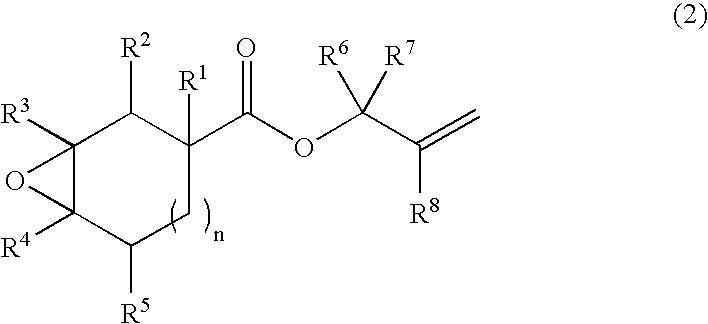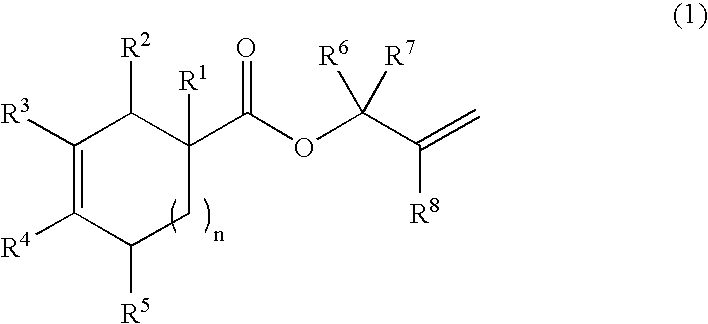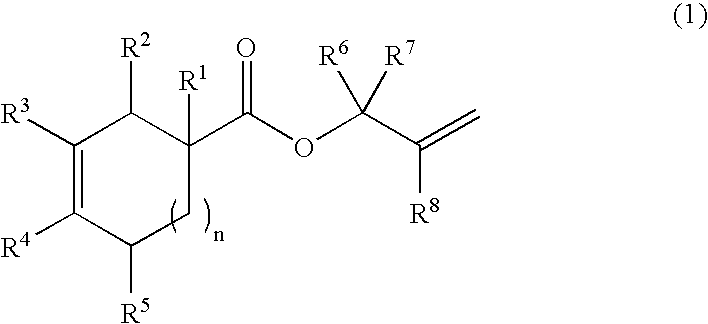Production process of bifunctional epoxy monomer by selective oxidation of diolefin compound
- Summary
- Abstract
- Description
- Claims
- Application Information
AI Technical Summary
Benefits of technology
Problems solved by technology
Method used
Image
Examples
example 1
[0036]After Na2WO4.2H2O (500 mg, 1.5 mmol), 40% hydrogen peroxide aqueous solution (7.65 g, 90 mmol), methyltrioctylammonium hydrogen sulfate (260 mg, 0.56 mmol) and 3-cyclohexen-1-carboxylic acid allyl ester (12.5 g, 75 mmol) were mixed, and were reacted at 25° C. for 15 min., the temperature was raised to 70° C., and the mixture was stirred for 3.5 hours. After the reaction was complete, the mixture was cooled to room temperature. Aftertreatment was performed with a sodium thiosulfate saturated aqueous solution, an organic layer was taken out. The obtained solution was determined by gas chromatography, and it was confirmed that the conversion rate of 3-cyclohexen-1-carboxylic acid allyl ester of a starting material was 79%, and the yield of 3,4-epoxycyclohexan-1-carboxylic acid allyl ester of a bifunctional epoxy monomer was 69%. The result that no diepoxides were formed, and monoepoxy selectivity was 100% was obtained.
example 2
[0037]After Na2WO4.2H2O (39.6 mg, 0.12 mmol), 36% hydrogen peroxide aqueous solution (600 mg, 6.3 mmol), methyltrioctylammonium hydrogen sulfate (23.4 mg, 0.05 mmol), aminomethylphosphonic acid (4.5 mg, 0.04 mmol) and 3-cyclohexen-1-carboxylic acid allyl ester (1.00 g, 6 mmol) were mixed, and were reacted at 25° C. for 15 min., the temperature was raised to 70° C., and the mixture was stirred for 3 hours. The same steps as in Example 1 were repeated. It was confirmed that the conversion rate of 3-cyclohexen-1-carboxylic acid allyl ester of a starting material was 89%, and the yield of 3,4-epoxycyclohexan-1-carboxylic acid allyl ester of a bifunctional epoxy monomer was 80%. The result that no diepoxides were formed, and monoepoxy selectivity was 100% was obtained.
example 3
[0038]After Na2WO4.2H2O (26.4 mg, 0.08 mmol), 36% hydrogen peroxide aqueous solution (400 mg, 4.2 mmol), methyltrioctylammonium hydrogen sulfate (15.6 mg, 0.033 mmol), aminomethylphosphonic acid (3.0 mg, 0.027 mmol), and bicycle[2.2.1]-5-hepten-2-methyl-2-carboxylic acid allyl ester (0.79 g, 4 mmol) were mixed, and were reacted at 25° C. for 15 min., the temperature was raised to 70° C., and the mixture was stirred for 3 hours. The same steps as in Example 1 were repeated. It was confirmed that the conversion rate of bicycle[2.2.1]-5-hepten-2-methyl-2-carboxylic acid allyl ester of a starting material was 74%, and the yield of 3-oxa[3.2.1.02,4]octan-6-methyl-6-carboxylic acid allyl ester of a bifunctional epoxy monomer was 70%. The result that no diepoxides were formed, and monoepoxy selectivity was 100% was obtained.
PUM
 Login to View More
Login to View More Abstract
Description
Claims
Application Information
 Login to View More
Login to View More - R&D
- Intellectual Property
- Life Sciences
- Materials
- Tech Scout
- Unparalleled Data Quality
- Higher Quality Content
- 60% Fewer Hallucinations
Browse by: Latest US Patents, China's latest patents, Technical Efficacy Thesaurus, Application Domain, Technology Topic, Popular Technical Reports.
© 2025 PatSnap. All rights reserved.Legal|Privacy policy|Modern Slavery Act Transparency Statement|Sitemap|About US| Contact US: help@patsnap.com



